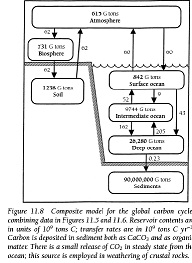Assignment: Energy and Climate: Vision for the Future
In order to understand Earth's climate and how it is influenced by our energy choices, it is important to understand basic principles of energy, heat, temperature, and water. In this assignment, you'll also see how the carbon cycle (both natural and anthropogenic) is intimately tied to energy and climate. You will visit a few websites in order to expose you to some of the energy and climate data available to you.
Conceptual and quantitative problems. You will only receive credit if you show all your work and write legibly.
I. Defining energy:
1. Energy is the ability to do _________________. It is neither ______________________ nor ______________________, but changes ____________________.
2. Conceptualizing Energy Units. In 2013, the New York Times printed a how-to for a "7-Minute Workout." It has been estimated that this workout burns approximately 75 kilocalories over the 7 minutes.
What is the rate of energy usage during the workout? Report your answer in Watts.
II. Properties of Water:
3. Label the phases of water in the following figure.

4. True or False. Warmer air can hold more water vapor.
III. Latent and Sensible Heat:
5. _______________________heat is required to change the temperature of water. _______________________ heat is involved in changing the phase of water.
IV. Heat Capacity and Specific Heat (Heat capacity per unit mass):
6. Water, air, and land heat up at different rates, which is evident when you jump from a hot concrete pool deck into a pool in the summer. These differences are very important in global weather patterns and the distribution of energy around the planet. The specific heats and densities are listed in the table below.
a. How much energy is required to raise the temperature of 1 cubic meter of water, air, and land by 10°C? Show your work and report your answers in Joules in the table below.
Material Density at 20°C, Specific Heat Capacity Energy required to raise temp of Solar heating time (hours)
sea level (kg/m3) (Joules/kg °C) 1 m3 by 10°C (Joules)
Water 998.2 4182
Air 1.2041 1005
Land* 3000 850
*Based on a range of values for different types of rock, just for rough estimates.
b. In the northern hemisphere, are surface winds (think about the pressure differences that drive winds) more likely to blow from the land toward the ocean in June or in November? Why? Use a diagram to explain your answer.
V. Carbon Cycle:
7. The process by which energy is stored in organic carbon compounds is _______________________________. The reverse process, in which energy is released from organic carbon compounds is called ___________________________________________.
8. Using the carbon cycle figure below, calculate the average residence time of carbon in each of the following reservoirs. Report your answers in years.

a. Define residence time using an equation and in your own words.
b. Deep ocean
c. Soil
d. Atmosphere
e. Sediments
9. Understanding carbon storage and release
a. The carbon in fossil fuels (coal, oil, and natural gas) belongs to which reservoir?
b. What is the role of plate tectonics in returning carbon from the sedimentary reservoir to the atmosphere?
c. What is the role of humans in returning carbon from the sedimentary reservoir to the atmosphere?
10. Navigate to the NOAA Carbon Tracker website.
a. Read the Global CO2 Budget section and study Figure . What are the two major sources and two major sinks shown in the figure?
b. What is proposed as the cause for the decrease in fossil fuel CO2 emissions in 2008 and 2009? Explain why this is the case.
11. The combustion of jet fuel (and other fossil fuels) can be simplified to the following equation:
CH2O (organic carbon compound) + O2 → CO2 + H2O
a. Visit the Carbon Dioxide Emissions Coefficients website, cfm and identify the amount of CO2 (in pounds AND kilograms) produced per gallon of jet fuel burned. (While you are at the site, compare the emissions from other fuel sources!)
b. A gallon of fuel weighs less than the amount of CO2 it produces, which you found in the previous question. How is this possible? (Hint: look at the equation above.)
12. Review the NASA Visualization Studio website. Here you will find hundreds of fascinating animations and data representations relevant to climate, energy, and many other things that can be tracked by satellites. Use the search box or click on galleries to find a visualization that is particularly interesting to you and relevant to something we are learning in SPU 25.
Visualization Title:___
How is it relevant, and why is it interesting to you?